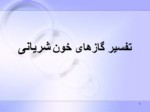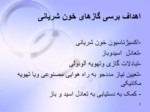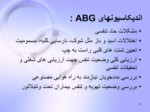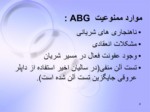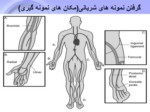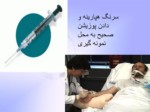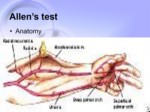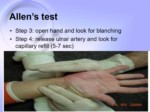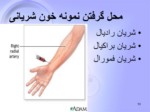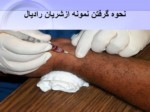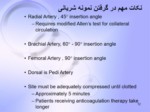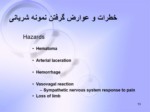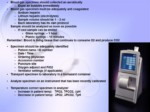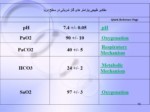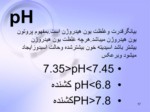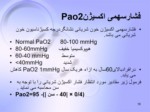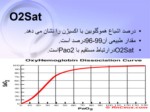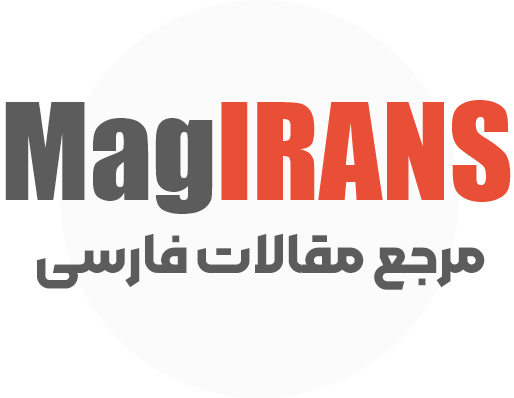بخشی از پاورپوینت
--- پاورپوینت شامل تصاویر میباشد ----
اسلاید 1 :
اهداف برسی گازهای خون شریانی
-اکسیژناسیون خون شریانی
-تعادل اسیدوباز
-تبادلات گازی وتهویه آلوئولی
-تعیین نیاز مددجو به راه هوایی مصنوعی ویا تهویه مکانیکی
- کمک به دستیابی به تعادل اسید و باز
اسلاید 2 :
اندیکاسیونهای ABG :
- مشکلات حاد تنفسی
- اختلالات اسید و باز مثل شوک، نارسایی کلیه، مسمومیت
- تعیین شنت های قلبی راست به چپ
- ارزیابی کلی وضعیت تنفس جهت ارزیابی های شغلی و تحقیقات تنفسی
- بررسی مددجویان نیازمند به راه هوایی مصنوعی
- بررسی وضعیت تهویه و تنفس بیماران تحت ونتیلاتور
اسلاید 3 :
موارد ممنوعیت ABG :
- ناهنجاری های شریانی
- مشکلات انعقادی
- وجود عفونت فعال در مسیر شریان
- تست آلن منفی(در سالیان اخیر استفاده از داپلر عروقی جایگزین تست آلن شده است).
اسلاید 4 :
سرنگ هپارینه و دادن پوزیشن صحیح به محل نمونه گیری
اسلاید 5 :
Allen’s test
- Step 1: tight fist x 20 sec
- Step 2: Occlude radial and ulnar arteries
اسلاید 6 :
- Step 3: open hand and look for blanching
- Step 4: release ulnar artery and look for capillary refill (5-7 sec)
اسلاید 7 :
محل گرفتن نمونه خون شریانی
- شریان رادیال
- شریان براکیال
- شریان فمورال
اسلاید 8 :
نکات مهم در گرفتن نمونه شریانی
- Radial Artery , 45° insertion angle
–Requires modified Allen’s test for collateral circulation
- Brachial Artery, 60° - 90° insertion angle
- Femoral Artery , 90° insertion angle
- Dorsal is Pedi Artery
- Site must be adequately compressed until clotted
–Approximately 5 minutes
–Patients receiving anticoagulation therapy take longer
اسلاید 9 :
خطرات و عوارض گرفتن نمونه شریانی
Hazards
- Hematoma
- Arterial laceration
- Hemorrhage
- Vasovagal reaction
–Sympathetic nervous system response to pain
- Loss of limb
اسلاید 10 :
- Blood gas specimen should collected an aerobically
–Expel air bubbles immediately
- Blood gas specimen must be adequately anti coagulated
–Sodium heparin
–Lithium heparin (electrolytes)
–Sample volume should be 1 – 2 ml
–Each laboratory has its own protocol
Sample should be analyzed as soon as possible
–If iced sample can be stored
»Glass syringe – 1 hour
»Plastic syringe – 15 minutes
Remember: Blood is living tissue that continues to consume O2 and produce CO2
- Specimen should be adequately identified
–Patient name / ID number
–Date / Time
–Ordering physician
–Accession number
–Puncture site
–Oxygen adjunct and FiO2
–Ventilator settings (if applicable)
- Transport specimen to laboratory in a biohazard container
- Analyze specimen on an instrument that has been recently calibrated
- Temperature correct specimen in analyzer
–Increase in patient temp: PO2, PCO2, ¯pH
–Decrease in patient temp: ¯PO2, ¯PCO2, pH
–

